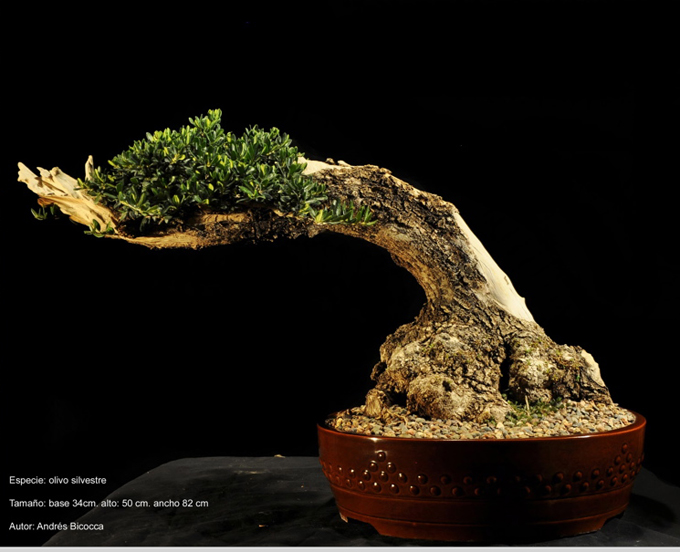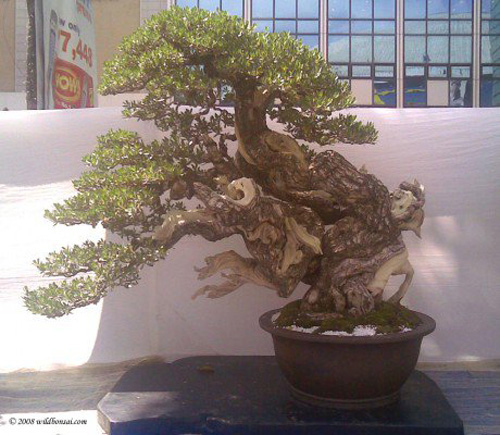 This one is an olive. And it is by Andres Bicocca. Who is from Argentina and isn’t from Uruguay. BTW: the way the foliage mass clings to the trunk, makes for a unusual looking bonsai. Though it has a wild, ‘work in process’ look, there’s something compelling about it with its strong nebari and well aged bark.
This one is an olive. And it is by Andres Bicocca. Who is from Argentina and isn’t from Uruguay. BTW: the way the foliage mass clings to the trunk, makes for a unusual looking bonsai. Though it has a wild, ‘work in process’ look, there’s something compelling about it with its strong nebari and well aged bark.
Egg all over my face
First, apologies to Argentinian (not Uruguayan) bonsai artist Andres Bicocca (see three posts ago). Second, apologies to Wild Bonsai; not only did I mis-attribute one of their trees but I mis-identified it as well (doubly embarrassing when you consider that their name is on the photo and the tree is clearly identified where it appears on Andres’ wall photos – thanks to to my virtual friend and unofficial fact checker Jose Luis Rodriguez for noticing this glaring error). It’s a Phemphis acidula, not a European olive (Olea europaea). So thanks Jose for keeping us honest and thanks Andres for your understanding, and thanks Wild Bonsai too.
 Another of Wild Bonsai‘s impressive trees. Our original mis-identified Wild Bonsai tree is below. Both are Phemphis acidula.
Another of Wild Bonsai‘s impressive trees. Our original mis-identified Wild Bonsai tree is below. Both are Phemphis acidula.
 Here’s the one I got all wrong. Notice the fine print on the bottom of the photo.
Here’s the one I got all wrong. Notice the fine print on the bottom of the photo.
“the way the foliage mass clings to the trunk, makes for a unusual looking bonsai.”
Mike Page does that to his trees all the time. But… whether you call that bonsai or not, is another matter.
Wayne,
Pemphis acidula from the Phillipines are among the best, if not the best in the world. Given the fact that the hunting grounds are along the typhoon path, weather/wind-blown specimens are the norm. Actually,some of the finest Taiwanese pemphis bonsai were developed from trees originally collected in the Phillipines.
Taiwan does have naturally occuring Pemphis, particularly in the Pescadores Islands and Kenting National Park. As this tree is extrememly cold sensitive, cultivation is limited to middle and south Taiwan. Actually, cultivation of Pemphis bonsai is very demanding. On healthy specimens, the brackish or salt water is a must and unique replanting methods are a norm (with the aide of pressure water or air compressor). Definitely, this tree species is not for everyone.
In the New World, Suriana maritima is a good substitute. This tree requires the same care and cultivation dexterity as pemphis.
Warm regards,
Jose Luis
Wayne,
Pemphis acidula from the Phillipines are among the best, if not the best in the world. Given the fact that the hunting grounds are along the typhoon path, weather/wind-blown specimens are the norm. Actually,some of the finest Taiwanese pemphis bonsai were developed from trees originally collected in the Phillipines.
Taiwan does have naturally occuring Pemphis, particularly in the Pescadores Islands and Kenting National Park. As this tree is extrememly cold sensitive, cultivation is limited to middle and south Taiwan. Actually, cultivation of Pemphis bonsai is very demanding. On healthy specimens, the brackish or salt water is a must and unique replanting methods are a norm (with the aide of pressure water or air compressor). Definitely, this tree species is not for everyone.
In the New World, Suriana maritima is a good substitute. This tree requires the same care and cultivation dexterity as pemphis.
Warm regards,
Jose Luis
Sorry Jose, for Pemphis, I dare to claim that Indonesia so far is the best, either on the material characters or the finished bonsai as well.. hehe….
We started this species long long before and have been an icon for Indonesian bonsai beside our Casuarina. Many people have misunderstood by saying giving salt water to these 2 species; in fact, it is not the case and not neccessary, the crusial part is the post handling method right after digging, then the maintaining method after planted in pot. Not saying certain prunning method is the key-factor to maintain good health and good shape of the bonsai.
For example, Malaysia and Thailand had been trying to grow Pemphis bonsai for many years but never succeed even they had put sea-water regularly..even with fish emulsion. At the end, the bonsai were dying slowly.
Since 2 years ago, I sent several Pemphis to Thailand together with my students to work in Thailand for a year to teach the caring method on Pemphis, now Thailand have several nice Pemphis including their local one, which they always failed in the past.
The same case to Malaysia since I sent 2 of my students to work for a collector in Penang, Malaysia.
A very special prunning technique and maintaining method is the golden key…
Coming back to the Olive in the first photo. I assume many of the Olives grown in the Mediteranean region are related to the edible fruit bearing Olive europaea. I would also assume that Olives in South America stem back to these trees in Europe. In South Africa a sub-species is naturally found Olea europaea supsp africana. It does not produce edible fruit, but has a much smaller glossy dark green leaf and often creates a similar type of root base (elephant foot like). It is often collected by bonsai artists and does very well as bonsai – it has a hard and very dense timber and is suitable for carving. Introduced Olives are similarly found in the Adelaide area in Australia where they have become somewhat of an invasive tree, but also produces good stock for collectors. I am of the opinion that the Africana subspecies is even more suitable to bonsai than it’s European counterpart. We have brought some South African Olives into New Zealand and they have adapted well to the wetter climate.
The best olive I have ever seen is in Spain..especially the wild olive, some of the characters are as good as our Pemphis…
Thanks Robert, Jose, Adriaan, Mark et al,
I’m on vacation, so won’t say much, except that I don’t need to say much. Your in-depth conversation speaks for itself.
Thanks again,
-w
Enjoy…Wayne….
Robert,
Yes, Indonesian Pemphis aer beautiful, with lots of character. That’s why I said that the ones in the Phillipines are ‘among the best’!
Depending on the area in Indonesia, the character changes. I have seen that those that hail from the southern Indonesian islands do no have as much character and tend to be a bit straight. Robert is right in one thing, Indonesian bonsai artists have managed to impose a character to Pemphis Acidula all of thier own. The foliage distributiong and the 3D character achieved in Indonesian designs is uncanny and of extremem quality.
Robert, you know that Indonesia, as well as Taiwan hold a special place in my heart!!!! I am sorry for not giving props to my Indonesian brothers!!!
Terimah Kasih, Selamat & Sukses,
Jose Luis
Robert,
My healthy pemphis do enjoy the sea water. In fact, yours get a daily dose. The water from the ditch in Pluit (where your nursery is located) has salt, among other things!
I have one that i added a diluted solution of sea salt and water regularly. After some time, the leaves became very thick and glossy, almost succulent like. My trees are healthy. I have seen that adding crushed lobster shell to the porous ‘soil-less’ mix is very good for them. It eliminates the possibility of nematode problems.
As far as pruning goes, if the trees develop a full head and it becomes necessary to perform heavy pruning, after cutting them, you can place them in a shaded ‘sweat’ house or place a plastic bag over the recently ‘heavy pruned tree’ and place it in the shade and protected from the wing and heavy sun. After five to seven days, hundreds of little leaves will appear. The bag should be removed bit by bit and exposure to the sun should be gradual and left to the time the leaves harden. (**These are methods that work for me, Robert may have another solution or idea**)
Kind regards,
Jose Luis
Pemphis, Casuarina and Premna..for these three species bonsai, I just can’t be humble..you know it Jose..haha….
In my last message I should of said, protected from the wind and heavy sun.
Anyhow, Olives from the Menorca and Mallorca region in Spain are very beautiful and full of character. In my opinion, the best!!
Yes Robert, we definitely can’t forget Premna! Also, Tamarind. Perhaps we can add Mirten (malpighia cocciguera), Triphasia, Mustam, the list goes on!!!!!
Thanks for reminding me!!!
Jose Luis